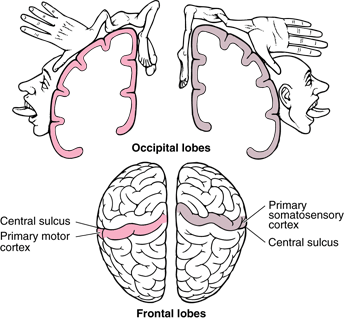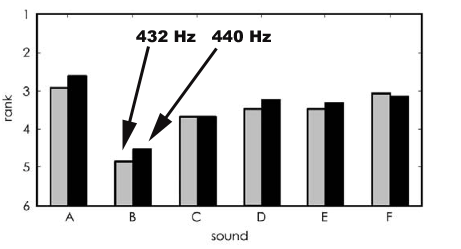

We all knew musicians were "different"
When neurologists stimulate the cortex, they notice that certain regions control the sensory input to specific areas of the body. The illustration below shows how the surface of the body is represented in corresponding regions of the cortex. Not all areas have the same sensitivity. The larger proportions show how many neurons are devoted to each part of the anatomy. This is sometimes called a "cortex map".

When the same regions were examined for musicians, it was discovered that these regions were markedly changed to suit their specific needs. Guitar players had enlarged regions corresponding to the hand involved in making chords, but not in the hand that strums the strings. Pianists had both hands enlarged on the cortex map and also certain regions of the anterior corpus collosum, which connects the two hemispheres and coordinates hand movements. Exceptional pianists also had marked spacing between each finger's cortex map.
Other differences were noticed in regions of the brain responsible for processing rhythm and pitch. But these differences were very specific. For example, a pianist could tell if a piano string was ever so slightly out of tune, yet would not notice the same fault in a violin, guitar or even a sine-wave tone generator. Each musician had used the brain's plasticity to their specific needs.
"These findings indicate that, after years of musical training, neuronal popula- tions in the auditory cortex might be shaped such that they automatically detect subtle changes in auditory stimulus sequences with simple or higher-order regularities. The para- meters that are needed for the acquisition of these skills are unknown, but probably involve initial attentive processing of the stimuli."
-- Elbert 1995
It's all about brain real estate
Neuro-scientists have learned that every skill has a corresponding plasticity that has been exploited. But there is a limit to our talents imposed by the physical size and number of neurons in our cranium. Often a valuable talent comes with a price. Development of one region of the brain means that limits are imposed on other potential sites. We often notice these idiosyncracies in talented celebrities who may lack common sense or suffer from personality problems.
An extreme example of plasticity gone wild is the so-called idiot savant who may be able to tell you the square root of a ten digit number or memorize a phone book but cannot tie his own shoes.

I was originally going to show you ancient musical instruments, many which used intuitive tuning that approximated 432 Hz (remember they had not discovered cycles or Hertz yet). But I kept thinking about the argument that 432 tuning causes a positive mental state, as well as physical health benefits over 440 Hz. I decided to look at the scientific literature to see if there had been any experiments to address this. I was greatly disappointed that the 440 paradigm seemed to pervade almost every study of the affect of music on the brain until I stumbled on a very recent, peer reviewed report, that came out just a few months ago.
Have a look at this:
Cognitive Neuropsychiatry. 2014 Jan 24 Abstract
Introduction: Participants were instructed to listen to the CDs over the next 18 months. Psychiatric symptoms in both groups were assessed at baseline and at 4, 8 and 18 months, using the Brief Symptom Inventory (BSI).
Results: Conclusions Exposure to the adapted music*(see below) was effective in ameliorating psychotic, anxiety and phobic symptoms. Based on the theories of neuro-plasticity and brain rhythms, it can be hypothesized that this intervention may be enhancing brain-rhythm synchronization and plasticity in prefrontal-hippocampal circuits that are implicated in both psychosis/paranoia and anxiety/phobic anxiety. *"adapted music" = (excerpt from report) "This "Mozart effect" can be intensified by playing the music composition slightly decelerated (as practiced in the days of Mozart). Furthermore, the instruments are tuned to the old French pitch of 432 Hz which corresponds to the harmonic ratio of natural body rhythms including ..."
|
While the above study doesn't claim that 440 Hz causes psychotic symptoms, paranoia and anxiety, listening to it did nothing to relieve the symptoms. And the 432 did improve these disorders! So... what do you make of that?
Below is a relatively short piece by Mozart (the 432 Hz composer featured in the experiment). Have a listen and see if it improves your mood.
Musicians hear music differently
If you ask a trained musician to listen to both 440 and 432 Hz tuned musical compositions you will likely hear that they prefer the 440 Hz version. This subjective analysis is based on the established fact that musicians' brains are arranged differently from normal non-musicians (like you and me).
For example, a trained musician processes pitch almost exclusively in their Left Ear (right brain) while non-musicians tend to use both. Non-musicians process rhythm in their Right Ears (left brain) while musicians rely on their Left Ear (right brain). This is something that is usually not addressed when recording in stereo and, although the tunes may sound great to the recording artist and his studio technician, the non-musical public may appreciate the results to a lesser degree.
Anatomical studies have shown that people who begin studying music in their childhood have a more developed (larger) Left Planum Temporale. Without using lots of Latin words and sounding like a neurologist, in general, musicians approach music from an analytic perspective -- real Left Brain stuff -- while the rest of us appreciate music holistically in our Right Brain.
(Journal of the Royal Society of Medicine, Volume 92, November 1999: "Variations on the Musical Brain" by Jason D Warren BMedSc MB)
I mention this because of a study that was conducted with music students where pianos tuned to 440 and 432 Hz were equipped with antique perforated piano rolls made by famous pianists playing classical pieces that were originally composed in the 432 Hz tuning. Thus, everything was identical except for the tuning method of the grand pianos.
The trials are listed below:

Not surprisingly, the music students who were trained in the 440 Hz standard showed a slight preference for the 440 Hz music. But the difference was not significant.

("Assessing the sound quality of a grand piano for different tuning standards", Journal of Acoustic Society of America, 114, 2409 (2003) by Hugo Fastl)
I have lots more to share about this topic but I would really like to hear from you and what you think and feel about this controversy. Most of the e-mail responses have been very positive but a few people are quite opposed to changing from the 440 Hz tuning standard. Some claim that an "A" just has to be 440 Hz. Period.
Some musicians claim that the 432 Hz tuned music sounds "off". While I have heard from others who have already re-tuned their bands and are playing exclusively in 432.
Remember, music is a subjective experience. Appreciating music for what it is (holistically) can be a Right Brain experience (the good side) and being too analytical (the stoic Left Brain) can mess with how you enjoy a piece that has been transposed or was originally recorded in 432.
So what can we do about this?
Post Script:
Since first publishing this story I've learned about some great bands that have successfully converted their tunes to 432 hertz. Surprisingly, one was very close to where I live.

The band is called JaSkaMon and there's no one else quite like this talented act in the NW; impressive in many ways, not the least because they play mostly originals and use an "island beat" reminiscent of ska, reggae and soca. I'll leave a link here.
